Customer churn is a very real challenge for businesses of all kinds. As a B2B business owner, you want to know how to reduce customer churn to prevent revenue loss.
Why do companies worry about customer churn? Can’t they acquire new customers to boost sales?
Yes, they can, but acquiring new customers and nurturing them costs more than retaining existing customers. Take a look at how much businesses in different industries spend to acquire just one new customer.
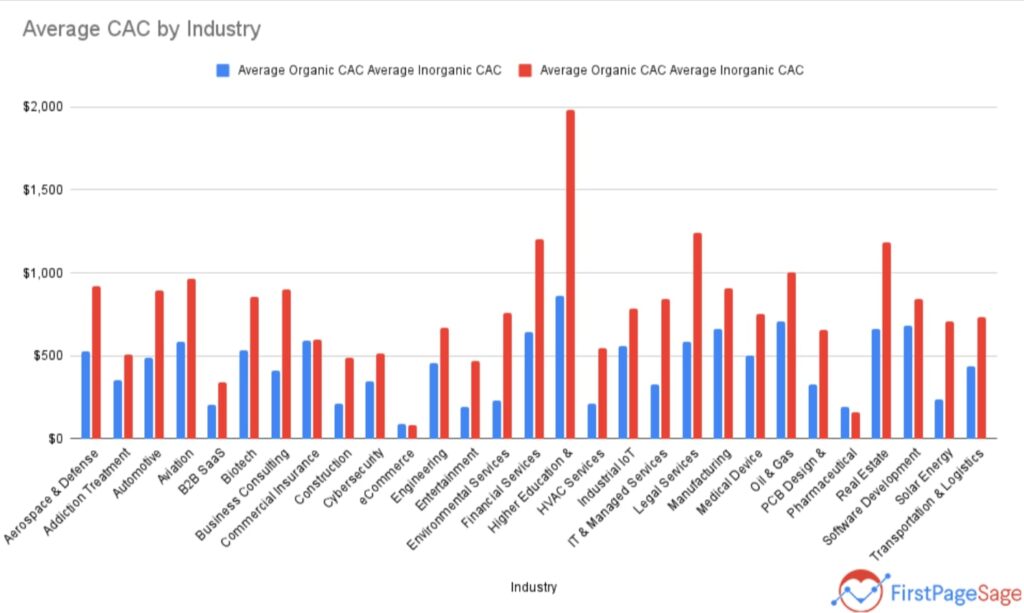
Image via FirstPageSage
Losing customers can significantly impact your overall revenue. A persistent and higher churn rate signals that your business strategy needs to change.
That said, you can predict when customer churn will likely happen and learn how to reduce customer churn. This is exactly what we’ll discuss in this comprehensive guide.
Let’s get started.
Customer churn refers to the loss of a client or customer, which significantly impacts your revenue. When your existing customers stop interacting with your brand or buying from you, this is considered customer loss.
Customer churn or customer attrition is a critical metric for measuring your B2B business health.
According to a recent survey, B2B businesses have an average customer churn rate of 3.8%. However, the numbers will vary based on your industry. In any case, a churn rate of 5% or less is considered healthy for B2B businesses.
Before learning how to reduce customer churn, you must first know what your current rate is. To calculate customer churn rate, divide the number of customers lost during a specific period by the total number of customers at the start of that period. Then, multiply by 100 to get the percentage.
Alternatively, you can use a free online calculator to calculate your business’s customer churn rate.
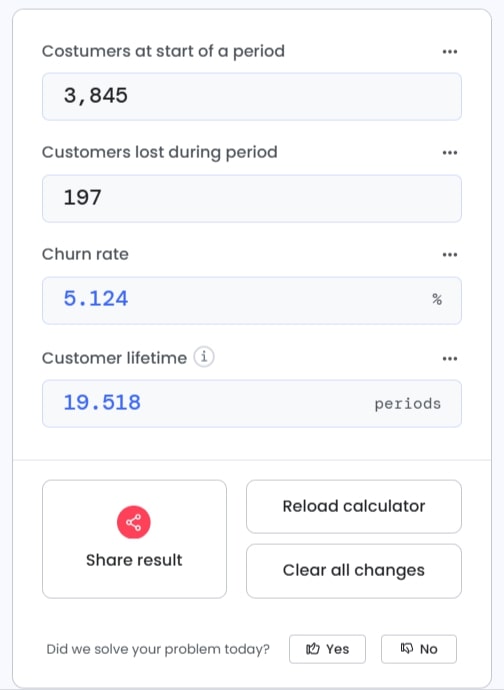
Image via Omni Calculator
Higher customer churn rate indicates:
Replacing high-value clients can be lengthy, complex, and expensive. This is why B2B businesses must learn how to reduce customer churn effectively. This isn’t just profitable; it also helps your business run more smoothly.
Also Read:
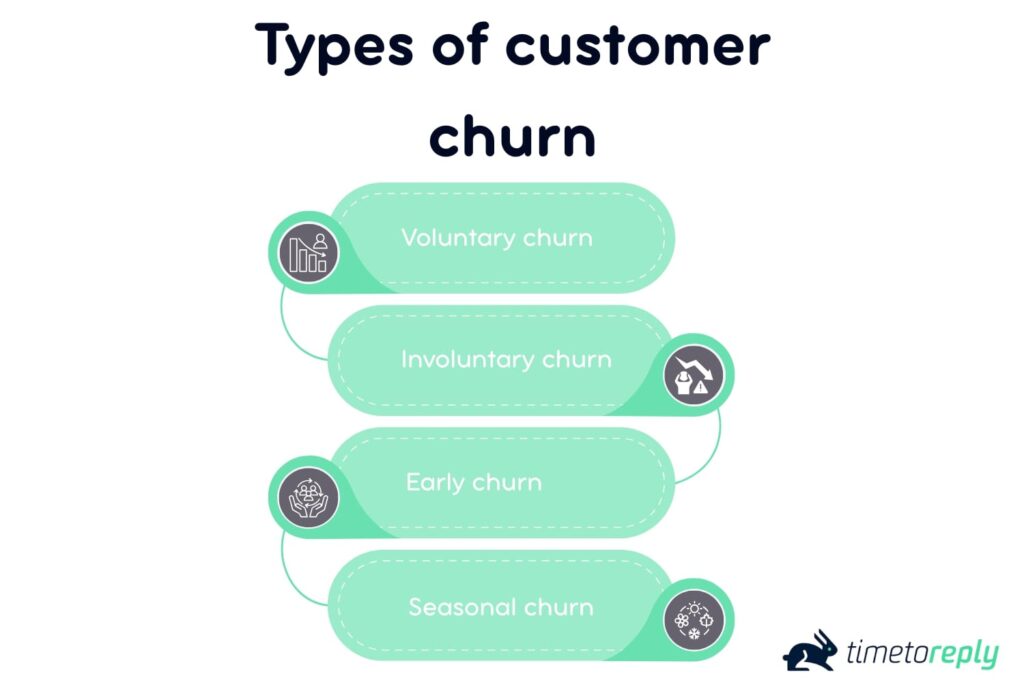
Before we discuss how to improve customer retention, you should first understand the different ways a brand may lose its existing customers.
Let’s take a quick look at the different types of customer churn.
The terms voluntary and involuntary churn are self-explanatory. Voluntary churn occurs when current customers willingly stop buying from your brand.
This could be the result of poor customer service, bad product quality, or competitive advantages. Over a period of time, you may also lose customers due to changing customer expectations and demands.
When customers passively leave your brand, we call it involuntary churn. They could have forgotten to renew their subscription or are facing payment issues.
Involuntary churn is unintentional, and the customer may not notice it most of the time. It’s easier to learn how to reduce customer churn when it’s involuntary. Just help them renew their subscription and offer incentives.
Early customer churn occurs when new customers don’t go back. After the initial interaction and purchase, the customer stops engaging.
Early churn could be a clear indicator of poor customer experience. You can reduce customer churn by offering good customer service and bringing these customers back into the sales cycle.
A certain percentage of clients are seasonal customers. They connect with a brand for seasonal or one-off purchases.
Based on their industry, they may join your customer base during the holiday season but may not continue to do business with you throughout the year. Here, you can design special plans to build brand loyalty.
Also Read:
A key aspect in understanding how to reduce customer churn is learning why it happens in the first place. Here are the main reasons why a customer could stop doing business with your B2B brand.
One of the reasons why new customers leave is that you may have an overly complex onboarding process. The way you introduce your products and services might be overwhelming to your customers.
This mental roadblock can make the adaptation process longer and stressful for them, causing them to leave early.
Businesses rely heavily on customer support. Clients should be able to easily reach out to your team when they face challenges. They expect you to reply quickly and provide quick and comprehensive solutions to help operate their business smoothly.
If you fail to do so, clients are more likely to look for brands that provide better support.
The most common reason for customer churn is when your product or service doesn’t meet customer expectations. When customers use your product, they expect results. It could be a revenue boost, better productivity, improved time management, and greater ROI.
When they don’t see the results they expect, this could negatively affect customer satisfaction. As a result, you could lose valuable customers.
If your customers regularly experience technical issues with your product, it could increase customer churn. Similarly, ineffective or outdated security measures could put your client’s business at risk.
When faced with such issues, customers are more likely to terminate the deal and move to a competitor who offers better technical efficacy.
Your competitors are striving to impress the same target audience. If they offer better pricing, more features, advanced support, or more comprehensive support, you might lose your valued customers.
For example, even if you have a better product, you could still have a higher churn rate if your competitors offer better incentives and more lucrative deals.
Do you have a strong customer retention strategy in place? Learning how to reduce customer churn starts with understanding what keeps your customers coming back. As a B2B brand, you must develop a comprehensive plan to engage customers. Having more loyal customers will increase customer lifetime value.
On the other hand, a weak retention plan could make customers feel neglected, causing them to leave.
Also Read:
Keeping existing customers is profitable for your B2B business in the long run. Here are 13 practical tactics on how to reduce customer churn rate and build a loyal customer base.
One of the most effective strategies for retaining existing customers is to deliver an exceptional customer experience. Your brand needs to be customer-centric.
Throughout the sales cycle, you can establish touchpoints to enhance the customer experience. Begin with a simple, easy-to-adopt onboarding process.
Work closely with your clients to understand their expectations from your product or service and align your efforts. Use your services to help clients work more efficiently and achieve stronger customer success outcomes.
Improved customer satisfaction helps build customer loyalty. As a result, you can increase a customer’s lifetime value.
Engaging and educating your customers is vital to connecting with them more deeply. One way to do this is to send regular updates, whether it’s via email or SMS.
You can also use multiple channels to explain how customers can maximize the use of your SaaS products. Share relevant and useful content, including how-to guides, tutorials, success tips, industry updates, and more.
Make your clients feel valued by offering them access to exclusive webinars and podcasts that can boost their performance. Quality and consistent customer engagement can significantly reduce customer churn rate.
Tailored marketing efforts are essential to reduce customer churn. Start by segmenting your paying customers based on their business size, industry, and product usage.
By creating various customer groups, you can study their common characteristics, challenges, and business value. Based on these valuable insights, you can customize your services to improve the customer experience.
Effective customer segmentation also helps distinguish high-value customers from at-risk ones. This way, you can create tailored deals to engage and retain these segments.
Also Read:
According to a study conducted by Shep Hyken, 83% of customers say excellent customer service builds brand trust. That’s why you need to ace the customer service game.
The future of customer service is all about accuracy, availability, and personalized solutions. Here are the experiences customers rate as essential factors to continue doing business with a brand.

Image via Shep Hyken
If you want to reduce customer churn rate, train your support team to deliver excellent service. Leverage the best customer service tools for smoother operations. Also, focus on providing practical solutions to help your clients operate smoothly.
Not all customers bring the same value to your B2B company. Some bring more value and require more attention.
But how do you determine customer value? You can conduct customer behavior analysis to estimate a customer’s potential value in the long run.
If a customer is enquiring about additional features, taking advantage of your offers and deals, or proactively renewing their subscription, talk to them.
Dedicate your best customer executive to engage such customers. Offer win-win deals to keep them coming back.
Be it the B2B or the B2C industry, customers always make sure they’re getting the most out of a deal. That’s where offering relevant incentives can be a game-changer.
Even if your product pricing is the same or higher than your top competitor’s, you can make your package more appealing by offering incentives. Instead of blanket discounts, diversify your incentives to attract various customer segments.
For instance, you can create reward programs for loyal customers, but for dissatisfied customers, you offer free upgrades. To help measure customer experience, you can also offer an exclusive discount for sharing feedback or participating in a case study.
Ensure that the incentives you offer are relevant and bring value to the customer beyond their investment.
Also Read:
Customer loyalty is hard to build. Once built, you need to make extra efforts to sustain customer trust.
According to the Shep Hyken survey mentioned above, 69% of American customers say customer loyalty programs are important to them. In other words, they expect you to recognize and reward them for being your loyal customers.
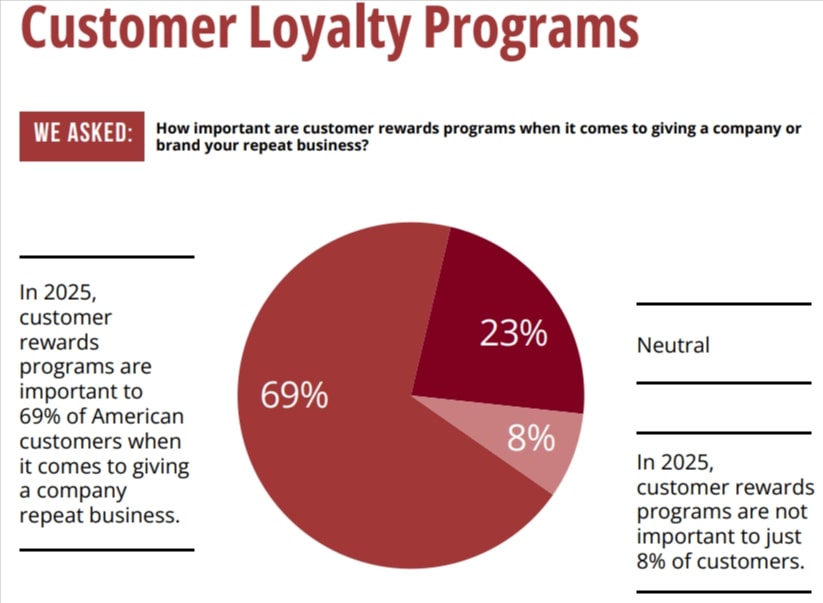
Image via Shep Hyken
Examples of rewards include early access to new features, free upgrades, a discount on add-ons, extra storage, and branded merchandise.
Remember that happy customers are easier to retain and have a greater customer lifetime value.
Who are the at-risk customers? These are buyers who are likely to churn if left unengaged, whether it’s due to voluntary or involuntary reasons.
How do you identify at-risk customers? Analyze customer data to segregate inactive, low-value, and dissatisfied customers. You can use RFM (recency, frequency, and monetary) metrics to identify customers who may stop doing business with your brand.
You can analyze their behavior to identify their pain points and use customized promotions to engage them more effectively.
Inactive users can also be categorized as at-risk customers. You need to adopt a tailored reengagement strategy to bring them back into the sales cycle.
You can begin by analyzing their purchase history and understanding why they stopped interacting with your brand.
In any case, these customers are still on your subscription list and remain as potential customers. So, you need to adopt solid engagement techniques to encourage them to do business with you again.
Offer personalized plans and lucrative incentives to activate these past customers and start generating monthly recurring revenue again.
Also Read:
Reducing churn entails meeting your customers’ expectations and nurturing them. This includes improving customer service by effectively handling unhappy customers.
Consumers nowadays expect a brand to respond to negative reviews within 24 to 48 hours. In other words, they expect the brand to take their complaints seriously and provide a solution.
Train your customer support team to monitor customer complaints and understand customer sentiment on multiple channels. You can use a reputation management solution to track negative comments and complaints and address them as soon as possible.
This will not only help reduce churn rate but also build a positive reputation that attracts more customers.
As we mentioned earlier, if you want a customer to do business with you for a long time, you need to build a relationship. Beyond generating revenue, look for ways to collaborate with your client to help them grow their business.
The human touch, empathy, proactive outreach, and exceptional service quality can help you deepen your relationship with customers. This way, you can establish trust and ensure your most valuable customers are happy doing business with you.
You can build stronger relationships with customers by clearly highlighting what sets your brand apart. It’s a way of reassuring them that they made the right choice in choosing you.
Keep in mind, competitors are constantly trying to win over your customers with new features or lower prices. To retain your audience and minimize churn, make sure your unique strengths are just as visible.
Create a mix of both informative and promotional content to highlight your product’s unique selling point (USP). Use social media marketing to showcase the features that make you stand out. Leverage newsletters effectively to keep your customers updated.
Showcase customer testimonials and top ratings to highlight why people love your brand. This trust factor encourages loyalty, helping reduce churn rate.
Also Read:
This might be a cliché, but customer feedback is one of the most practical ways to curb customer churn rate. We encourage you to gather feedback from existing and churned customers.
Right from the time you onboard a customer, you can ask them to share feedback at different stages of the sales cycle to measure the efficiency of your retention strategy.
You can ask questions about usability, product quality, customer support, pricing, and what the customers feel could be improved. There are plenty of customer feedback tools, such as timetoreply, that can help create customer surveys.
The insights you gather will help you analyze customer churn. When you understand your shortcomings and your customer’s reasons for leaving, you can build a more effective retention strategy.
The fact of the matter is that you can’t stop customer churn completely. Customers will leave your brand for one reason or the other.
To measure your brand’s health more effectively, you need to analyze your customer retention rate in comparison to your churn rate.
According to a report by ChartMogul, B2B companies have a customer retention rate of 85%. This is better than several top industries.
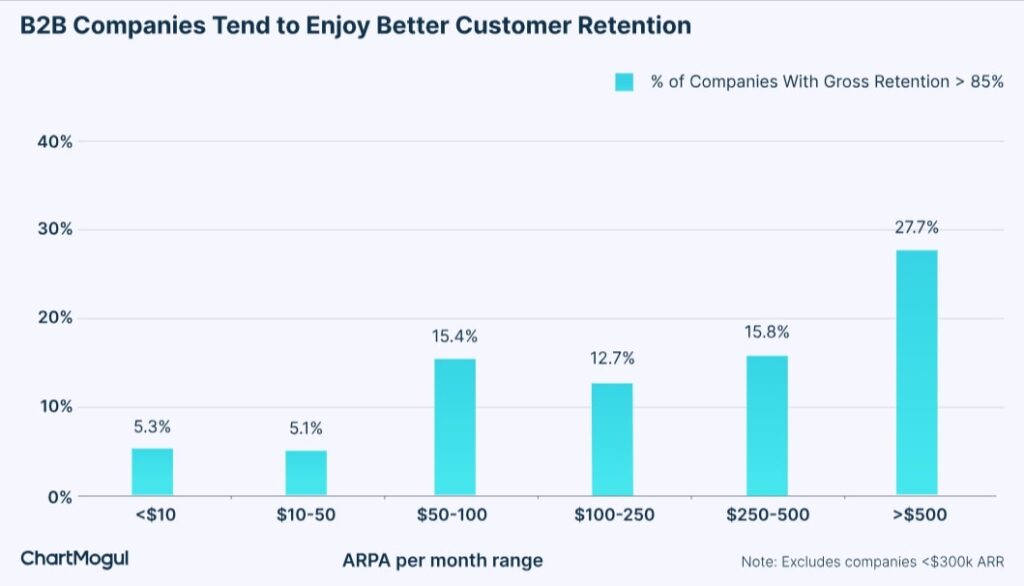
Image via ChartMogul
If your B2B company’s gross customer retention rate is around 85%, you’re doing a great job. It also indicates that you have a satisfied and loyal customer base.
However, if your rate is far less than the ideal numbers, you need to analyze your retention strategy and adjust accordingly. This ensures that your customers stay loyal to your brand for a longer period.
Also Read:
1. What is a good customer churn rate?
Customer churn rate varies by industry. For B2B SaaS companies, an average churn rate of 3%–5% is considered good. A higher churn rate means you’re losing customers regularly. You need to adopt robust and immediate corrective measures to protect your customer base.
2. What are the impacts of customer churn?
Some of the major impacts of customer churn are:
3. Is churn a key metric for B2B SaaS businesses?
Yes, customer churn is a key metric for quantifying business success. A higher churn rate may mean that you have a weak retention strategy. It also hints at weaknesses in product quality, usability, and customer service.
A lower churn rate indicates business stability and consistent performance. When you can retain valuable customers for years, you’re more likely to be profitable.
4. What are the reasons for customer churn?
Some of the common reasons for customer churn are:
5. How do you reduce customer churn and build loyalty?
Here are some effective strategies to retain customers and strengthen loyalty:
6. What are the 3 R’s of customer retention?
Reward, recognition, and relevance are the 3 R’s of customer retention. To build customer loyalty and reduce churn, you need to recognize the clients who trust your brand. Then, reward them with relevant incentives to ensure they continue doing business with you.
Customer churn is inevitable. However, it rarely happens overnight; rather, it builds over time.
That’s why your customer retention strategies should be proactive, not reactive. Don’t wait until a partnership is at risk; consistently nurture each client at every touchpoint throughout the customer journey.
Build a customer-centric culture where you actively participate in customer success and grow together. Build and deepen customer relationships to establish brand loyalty. Treat your most valuable customers with utmost care.
Implement the customer engagement and retention tactics shared in this guide. You’ll not only reduce revenue churn, but you’ll also be able to deliver an exceptional customer experience.
Lastly, use timetoreply to stay responsive and make the most out of every customer interaction.
Get live inbox alerts and reply quickly to customer emails with timetoreply